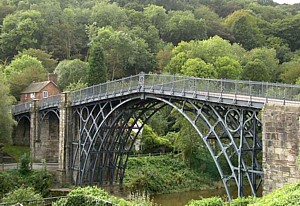| Introduction
(back to top)
- On Tuesday (4/11) I was in Indiana, presenting some of my research
on post-1945 Dachau, the origin of the quotation "First they came
for the Communists..." (my Niemöller
Quotation page), the Berlin national victims' memorial (1997 essay),
and the Los Angeles Museum of Tolerance (2001 article).
- Thus I previewed several videos about the Industrial Revolution that
might substitute for my lecture on that topic. To explain my choice,
let me begin by describing them:
- My first choice was one called "The Factory and Marketplace
Revolution" (1985), in the series "The Day the Universe
Changed," narrated by James Burke.
However, neither UCB nor UCSD would loan their copies, and UCSB
doesn't have one.
- I like this one particularly because of the way it presents
the various factors--causes--that came together to produce this
world-historical change in the late 1700s that set "the
West" on the path to becoming the "First World."
- blurb: "A
segment of the PBS broadcast of James Burke's The Day the Universe
Changed. This segment was broadcast as Credit Where It's Due.
"In 18th century England, the industrial revolution got
its impetus from growing wealth and industrious religious Dissenters,
barred form all activities but trade. These Dissenters, using
innovations in business and credit, created a new industrial
society, based chiefly on the steam engine, a Dissenter invention.
We see the growth of urbanization, the factory system, an industrial
working class, and the exploitation of the planet. Notes: Written
and produced by James Burke. Music by Cor Davis. Edited by David
Pygram. Researchers: Betinna Lerner, Penelope Fairfax and Joy
Hornsby."
- UNC
Western Civ course study guide
- available for $80
from buyindies.com
- Educational Video Network, "Industrial Revolution" (1995)
(two parts 22+20 mins., held by UCSB Kerr Hall, V-4206A+B).
- This is the one I ended up showing, see below.
- WGBH (Boston, PBS) "Industrial Revolution" (1989) series
narrated by Eugen Weber (UCLA); prog. #41: The Industrial Revolution
-- Technology and mass production reduced famine and ushered in
higher standards of living," and #42: The Industrial World
-- A consumer revolution was fueled by coal, public transportation,
and new city services. (two times 30 mins., UCSB Kerr Hall V-2134-EE+FF)
- this is a very traditional lecture (albeit with lots of good
images) by an "old school" professor. He walks the audience
through innovations, mostly of the 19th century.
- I liked best the second half of the 2nd tape, in which Weber
talks about how the lives of common people in cities changed because
of industrialization.
- CNN's Millennium series (1999), 10 hours, narrated by Ben Kingsley.
- "Episode
Nine: Industrialization altered the world's balance of power in
the nineteenth century. During the "century of the machine,"
Western powers established world empires by means of technological
superiority and became more powerful than the big-sister civilizations
of China, Islam, and India. Other cultures tried to resist the influence
of the industrial powers but ultimately failed, losing ground to
new modes of living."
- My colleague, UCSB Prof. Sachsenmeier, who teaches Global 1, a
1-quarter "Global History, Culture, Ideology" overview
in the Global Studies program (his
homepage), recommended this one, which I did not preview.
- CNN series
website for episode 9 (It appears to focus more on the 19th
century.)
- $8 used
at amazon
|
